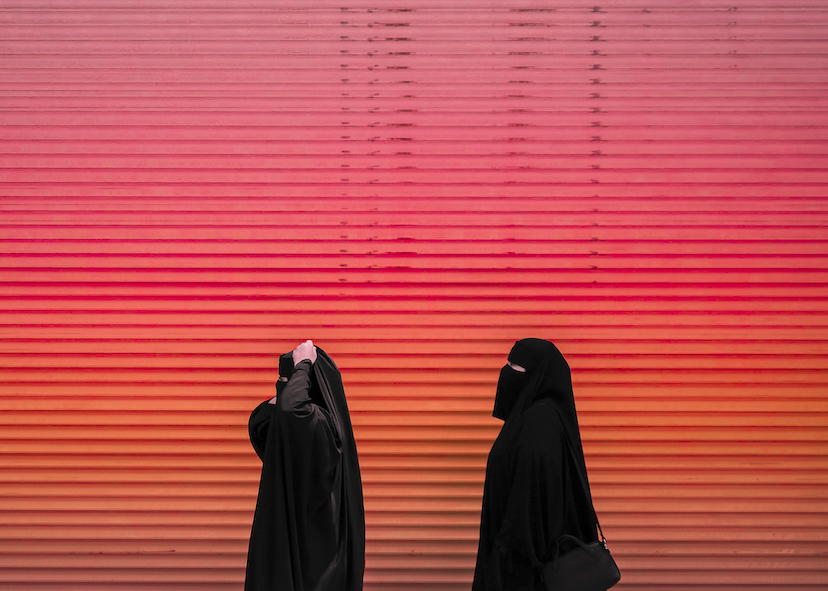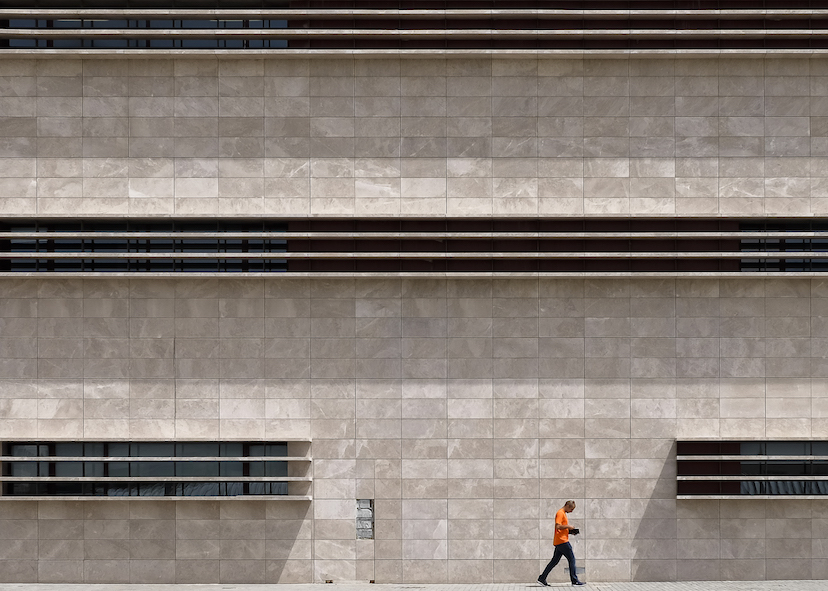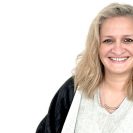It was February 2016 when local abstract, minimalist and street photographer Bader Al Rajhi first discovered our publication. The February cover featured a soulful capture of a beautiful corner in Kuwait’s Al-Mubarakiya district by renowned architect and designer Waleed Shaalan, and our cover made Bader ponder the moment that the photo was taken.
“I went back to same corner several times, and wanted to replicate the angle but with a human element.” He waited patiently, until that prized moment arrived. I asked him if the human element was ever staged, “Where’s the hardship in that?” He chuckled, “I prefer it when the human element arrives organically, so I waited for those magnetizing lines to appear as the light changed in that corner, and with passers-by, I knew I had my shot.” Fast forward to February and March 2018, and we see the treasured work of this artist gracing our covers. We’re clearly obsessed.

Bader considers the Al Mubarakiya quarter as a learning arena for every aspiring photographer. He explained, “From getting to know the local culture, to really appreciating the hunt of seeking beauty in the most unassuming moments—it is a breeding ground for creative thought.”
To better understand Bader’s artistic journey, we delve back in time, precisely twenty years ago, to when it all started. “I first picked up the traditional camera to document Kuwait City’s rapidly changing architectural landscape. A lot of the old buildings that once made up the city’s urban landscape are now gone. Take a look at Souq Al Mubarakiya today, and you wouldn’t be quick to notice how this area along has changed, from the products sold to the people who frequent it.”
1998 was a different time for any aspiring photographer. Social media didn’t exist, and neither did the advanced, digital cameras that are widely available today, even on the typical smartphone. For Bader, investing his time in photography was an all-consuming passion, “Photography was once a costly hobby, from the actual equipment used to the film, to the production of the printed photos.” This didn’t stop the history and art lover, and antique collector to continue his journey of documenting a rapidly changing Kuwait, and its architectural heritage. From 1998 to 2008—that was Bader’s focus. While many of us might know the photographer from his popular Instagram account @The_Rhythm, you can reacquaint yourself with Bader’s photographic journey by following @Bader_Mirror. In this new account, Bader showcases different genres of photography, Kuwait’s archictural heritage, photographs documented by traditional film cameras, as well as how far his vision has come since he first began his creative journey. With the account @The_Rhythm, we can clearly experience Bader’s refined vision, presenting abstract, minimalist and street photography that speaks to Kuwait’s current cultural landscape.

With the onset of digital photography and social media, however, Bader’s journey took many fortuitous turns.
Completely self-taught, Bader honed his skills further by immersing himself in the world of arts and photography. Reading, discovering different genres of art, to even painting—the creative world constantly inspires Bader. This photographer even used to paint! He said, “While I loved to paint, I have many incomplete works. I think that, with photography, I am better able to present my vision.”
For Bader, one of his earliest challenges that he faced with photography is one that he overcame when he better understood it: Finding the right location, as well as the perfect timing. Once he spent more time understanding his local cultural landscape, his focus grew. “I love capturing cultural identities, but presenting them differently,” he went on to explain, “Nowadays, I generally envision the finished shot in my mind. Once I’ve imagined it, I set forward using the tools available to me to capture it.”
In 2012, Bader decided to focus his photography skills further. We spoke of various art genres, with his passion lying deep in abstract art and understanding where and how light travels. From renaissance art, realism, impressionism to surrealism, Bader kept coming back to abstraction. He said, “Abstract art and photography captured my attention. I love abstract architecture, so I began researching the idea online.” Practice, back then, was based on what he saw from other people’s works—emulating and teaching himself to better understand how to refine his craft. In 2013, Bader noticed that his definition of the genre changed, and became more explorative.

“I shared a photo in a specific style that was, at the time, unfamiliar to Kuwait. A fellow photographer saw the photo and decided that the picture was “wrong” or incorrect. I deleted the photo, and then blamed myself. I shouldn’t be listening to what people are critiquing, but rather I need to better research the area. I needed to visualize the abstraction I wanted to present, and not recreate it because I saw it presented in a specific way.”
When it came to the actual research, it was easier said than done, as Bader uncovered a wealth of resources when it came to abstract art and its origins When it came to abstract photography, however, it was up to Bader to translate what he learned into his photography. “Local and foreign resources were pretty much the same. When it comes to abstract photography—which wasn’t very popular at the time—the result of the photo needs to emit an anonymous feeling, and a sense of mystery. Internet, books, and magazines, Bader studied the field of abstraction as it applied to not only art, but also philosophy, language and humanities. He also consulted with the college of arts in Kuwait, met with abstract artists like the talented Dr. Abdelrasool Salman and Abdullah Al Otaibi to learn more about his experience, “We spoke in length, discussing the genre and critiquing my work. I felt at ease, as I knew I was on the right track. I don’t want to ever lecture or present work that was inaccurate.”

From there, Bader applied everything that he learned. “Everything and anything can be abstracted—we can showcase reality not as it appears, but also how we perceive it using the tools we have. I love abstract art because you can apply this school of thought to not only still objects, but also people. I love it when an image isn’t 100% obvious.” A thorough exploration of his Instagram account best exemplifies his signature style of abstract, minimalist and street photography, and marks the main reason why we cannot get enough of Bader’s work. At first glance, we identify with the locale he presents, only to feel something entirely different. Cultural identifiers can be clichéd at times, but with Bader’s unique perspective, we feel emotion, and see beauty in places that are often overlooked.
Today, Bader perceives his work and 20-year journey with pride, love, and an endearing humility at how much he endured to learn to capture these moments and visual presentations. Bader is very open about his acquired knowledge and has led a multitude of free-of-charge, workshops and lectures to help fellow creatives follow suit, specifically when it came to abstract, minimalist and street photography. Bader further considers the camera as a powerful machine with features that are rarely explored. “To me, that’s where the real fun started,” he laughing explains, “I got to present reality as I saw it. I decided to follow my instinct and let the camera and its incredible tools serve my vision.”

On his workshops, he is simply inspired by his passion, and wishes for people in Kuwait to embrace abstract art and photography, “I want to dispel the myths that surround abstract, minimalist, and street photography. It’s not just about alluding to a sense of mystery, but it is also about deconstructing reality. Once people better understand art as a way of thought, that is when societies and perceptions are truly changed.”
It comes as no surprise to us that Bader continues to lead lectures and photography workshops. He easily explains technical terms that can be mind boggling in a calmly spoken manner. You can tell that his advice is spoken from a place of knowledge and deeply rooted passion. We asked him for some quick tips to make our own captures look better, to which he replied, “Places stay still, but time passes. Once we understand that, we can get creative. With unique thought, your work will stand out without emulating someone else’s. Let’s not follow trends in photography or art, but instead let us follow imaginations that we come up with.”
For more information follow Bader Al Rajhi on Instagram @The_Rhythm and @Bader_Mirror.








